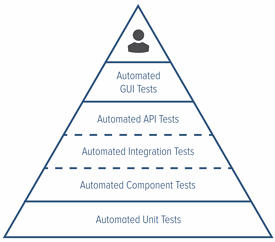Take a faster, smarter path to AI-driven C/C++ test automation. Discover how >>

Automated testing performs software testing more efficiently than manual testing with repeatable tasks so development teams can focus on higher value activities.
Even software development newcomers know that all products must be tested, but they might not know the value of automated tests.
Manual testing can only go so far. It helps to have testing tools that incorporate automation to reduce time-consuming methodologies.
Since debugging is crucial to the development lifecycle, why not leverage tools that allow teams to find potential issues with better efficiency and at earlier points in the development cycle?
Automated testing validates that software is working as intended before it gets pushed to production.
Testing automation relies on scripting as executed by test automation tools. This allows for even better Agile workflows, continuous delivery, more comprehensive tests, and other highly useful benefits.
Parasoft excels at incorporating automated testing across a variety of disciplines with a test suite of solutions like Parasoft Selenic, Parasoft SOAtest, and more.
Improve your team’s efficiency, efficacy, and software quality by incorporating various automated types of testing.
Reduce the cost of high-quality software development without sacrificing time to market. Utilizing end-to-end tests that include functional testing, performance tests, and regression tests as part of your automated testing strategy augments the SDLC.
Parasoft provides the automation that continuous integration teams need to move faster and focus on the code and activities that matter. Automated tools and techniques, such as automated unit testing recommendations and assertions, AI-powered test creation, and test impact analysis, help users build maintainable unit, API, and UI tests.
The functional tests provide the greatest return on investment in testing because they are closer to the code and reduce the overall time for defect remediation. These tests can be created earlier in the software development process, are easier to automate, easier to understand, and ultimately easier to diagnose the root causes of regressions and test failures.
Even with automated testing, manual testers will still need to spend time performing manual testing. The goal is to ensure they prioritize UI testing on client-side logic and the user journey, as UI tests are difficult to automate, take longer to run, and must wait until the entire application and test environment are available.
Performing only manual testing or UI testing leads to limited test coverage, more risk, and more defects leaking into production.
One of the key principles of the agile methodology is responding rapidly to change, but the key to success is delivering the response to that change in the most efficient way possible. Other tools help automate the execution of tests and stop there.
In addition to automated test creation and execution, you get meaningful information to help you understand exactly which tests need to be executed when application code changes with Parasoft.
Without this, testers have to execute all of their tests all the time, without knowing how to prioritize the feedback and understand which code changes have been tested.
Parasoft tools are designed to scale with your testing strategy from the individual all the way to the full enterprise. Easily integrate these testing solutions with your preferred industry IDE and CI/CD build applications.
As your testing requirements increase, know that your investment can be leveraged seamlessly across the team and into the test results dashboards — all while enjoying the enterprise benefits from corporate-level visibility.
The types of tests available run the gamut from basic functional tests and performance testing to exploratory testing, integration testing, and other testing solutions.
For instance, a programmer automating acceptance tests will have an easier time than someone trying to automate usability testing. The former has a more predictable result while the latter requires random human gestures as the input. This can prove difficult to automate.
The most common and easily automated types of tests are:
To benefit most from agile, you need efficient test automation and test automation tools to quickly validate incremental changes and make sure you aren’t building on top of broken functionality. The now infamous test pyramid provides a blueprint for how to build a scalable agile testing strategy.

The first step is establishing a solid practice of static code analysis that is effective in preventing reliability and security defects from entering the codebase.
Next is the creation of a comprehensive foundation of unit tests to ensure good code design and identify regressions at the earliest stage.
Moving up the pyramid, API/service-level tests enable fully automated testing of your business logic, and at the top, a minimal number of brittle and expensive end-to-end UI-centric or manual tests.
Beyond the pyramid, there are some general best practices to always keep in mind when implementing strategies for automating tests:

The earliest place where testing can have a huge impact is when development is writing the first line of code. Parasoft provides deep static code analyzer tools for Java, C, C++, C#, and .NET frameworks, to prevent potential bugs and security vulnerabilities that could lead to defects down the line.
Through this preventative testing technique, organizations can ensure that the underlying code is both secure and reliable from the beginning.
To test at the pace of Agile, a solid foundation of unit tests is essential. Parasoft provides tools that help organizations make this first step of the pyramid less expensive and time-consuming.
Parasoft Jtest (for Java) and Parasoft C/C++test (for C and C++) make it easier to create meaningful, predictable, and maintainable unit tests, leveraging artificial intelligence and test impact analysis so the team can both achieve high levels of test coverage for the code that really matters, and quickly focus in on areas of risk in the application.
To avoid the inverted testing pyramid, which occurs when organizations focus primarily on application validation through UI testing, look to an “automate-first” strategy that starts at the API/service layer.
Parasoft SOAtest was designed from the ground up to seamlessly test at the service layer (REST, XML, JSON, SOAP, MQ, and others), and combines these tests with interactions through different channels of the application (API, Web, mobile, databases) to provide automated end-to-end omnichannel tests.
In order for your test portfolio to be valuable, in addition to being automated, your tests must be executed continuously. But as you get higher up the testing pyramid, tests become more dependent on systems that are out of your control.
With Parasoft, unit tests can be easily isolated using test doubles (stubs and mocks), and API and UI-driven tests can use service virtualization and dynamic testing environments to enable continuous testing.
To modernize your testing practice, it is critical to understand the details of the underlying codebase, ensure all changed code has been tested, and understand where risky parts of the codebase exist.
With Parasoft, you can merge coverage across all of your testing techniques, to give you a complete map of your testing practices with traceability down to specific test cases and requirements.
In agile development and testing, you are dealing with constant changes to both your application and other teams’ applications that your application communicates with. This reality can cause test automation to break down when these ever-changing test environments become unstable and create noisy false positives.
With Parasoft’s integrated service virtualization and environment management features, testers can deploy lightweight virtual services that behave just like the real systems in the ecosystem, to create a predictable test environment that is ready when you are.
UI testing is essential for validating the customer experience, but the cost and effort associated with maintaining your UI tests takes away from other critical testing practices. As a result, you can get stuck in a never-ending UI test maintenance death spiral.
With Parasoft Selenic, you can reduce maintenance costs associated with UI testing and keep your existing Selenium framework in place. Leveraging AI, Parasoft Selenic gives you automatic recommendations to fix broken tests post-execution when you can choose to self-heal tests at runtime. Selenic enables you to spend less time at the top of the pyramid.

A concept known as “shifting left” is a crucial part of fully utilizing agile development. Whether you are testing mobile applications, a software product, or any other of the many types of software testing, finding a way to automate processes must happen to benefit the most from agile development.
Many tools are open source, work across many programming languages, and can run tests for lots of issues. Start with this to-do list on how to incorporate automated test management and quality assurance into your workflow:
Adapting an automation strategy is an essential part of a successful agile dev ops practice. Without rapid feedback on the quality of an application, organizations cannot release with confidence to meet their business and CD pipeline goals.
Parasoft makes automation testing a reality, enabling teams to get immediate feedback with continuous validation of quality, at each stage of the development process, from unit testing through API testing to UI testing and beyond, ensuring they can efficiently meet both time-to-market and quality requirements.
Parasoft’s cutting-edge software testing technologies give you better insights, with more actionable information to help teams assess and prioritize risk.
For the most efficient software testing practice that can scale at the rate of agile development, deploy Parasoft and deliver continuous quality at speed.

